Halifax Area
Halifax County
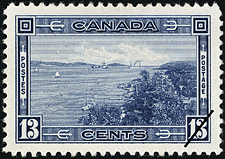 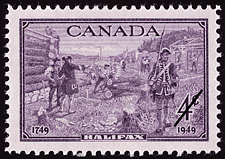
© Canada Post Corporation, 1938, 1949. Reproduced with permission.
These stamps show the entrance to Halifax Harbour looking seaward and
a scene of men building
structures following the founding of Halifax
in 1749.

© Canada Post Corporation, 1991. Reproduced with permission.
The Halifax Public Gardens, established in 1867,
are a rare example of a Victorian public garden in the heart of a modern city.
 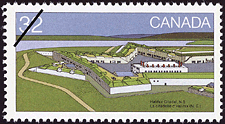
© Canada Post Corporation, 1982, . Reproduced with permission.
The Old Town Clock
and the Halifax Citadel
have played an integral part in the history
and development of Halifax and sit prominently above
Halifax's downtown core.

© Canada Post Corporation, 1985. Reproduced with permission.
York
Redoubt is one of many fortifications in the Halifax area. The network
of forts provided protection to Halifax Harbour and the City of Halifax until
after the Second World War.

© Canada Post Corporation, 1954. Reproduced with permission.
Sir John Sparrow David Thompson
(1845 - 1894)
Premier of Nova Scotia May 25, 1882 - July 18, 1882
Prime Minister of Canada Dec. 5, 1892 - Dec. 12, 1894
Born in Halifax, Thompson had just been named to Queen Victoria's Privy Council when he died
of heart failure in Windsor Castle. He is buried in
Holy Cross Cemetery in Halifax.

 
© Canada Post Corporation, 1984, 2000. Reproduced with permission.
Nova Scotia has a rich sailing history.
Today's modern Tall Ships have visited Halifax many times
since
the first Tall Ships Festival in 1984.
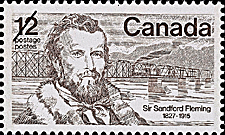 
© Canada Post Corporation, 1977, 2002. Reproduced with permission.
Sir Sandford Fleming (1827 - 1915)
Canada's foremost railway surveyor and construction engineer, inventor of international standard
time and designer of Canada's
first stamp. Fleming offered 95 acres of land at the Dingle on the Northwest Arm as a park for
the people of Halifax, where he died in 1915.
 
© Canada Post Corporation, 1998, 2005. Reproduced with permission.
HMCS Sackville, one of the last corvettes to
protect North Atlantic waters during
World War II's
Battle of the Atlantic, is docked on the Halifax Waterfront at
the Maritime Museum of the Atlantic.

© Canada Post Corporation, 2010. Reproduced with permission.
The Royal
Canadian Navy celebrated its 100th anniversary in 2010.
HMCS Halifax
was the first Halifax Class frigate built for the Canadian Patrol
Frigate Programme.
It is assigned to Maritime Forces Atlantic at
CFB
Halifax.

© Canada Post Corporation, 1996. Reproduced with permission.
Halifax, and Atlantic Canada, have long been viewed as the centre of Canadian ocean
science and technological initiatives.
The stamp includes a 3D representation of the
floor of
Halifax Harbour.

© Canada Post Corporation, 2002. Reproduced with permission.
Peggys Cove, located 1/2 hour from Halifax, is known for its
high seas, rugged beauty,
and as a paradise for artists such as resident
William deGarthe.
A post office was formerly
located in the lighthouse.
 
© Canada Post Corporation, 2000. Reproduced with permission.
Halifax has a rich cultural tradition and arts scene including Neptune Theatre whose
origins are rooted in the 17th
century performances in Port Royale.
Portia
White (1911-1968), originally from Truro, began her singing career in
Halifax
and went on to the stages of New York as a classical concert singer in the 1940s and 50s.
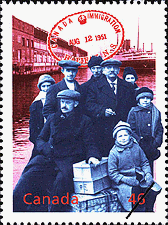
© Canada Post Corporation, 2000. Reproduced with permission.
From 1928 until 1971, Pier 21, now a National Historic Site, was Canada's
gateway
for over a million immigrants.


© Canada Post Corporation, 1984, 2002. Reproduced with permission.
Halifax is home to several colleges, universities and professional schools, including
Dalhousie University
with it's Law School, and Saint Mary's University.
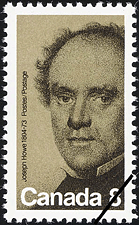

© Canada Post Corporation, 1973, 1958. Reproduced with permission.
Joseph Howe (1804 - 1873) - Journalist, Orator, Politician
Premier of Nova Scotia 1860-1862
Lieutenant Governor of Nova Scotia 1873
A powerful champion to
responsible government
(January 1848) by which Nova Scotia was the the first British Colony to be
governed. He opposed Nova Scotia joining a Canadian nation but eventually relented and became one of the Fathers of
Confederation. His statue stands next to the
Nova Scotia Legislature
(built 1819) which is a monument its own right to
Canada's first elected General Assembly
(1758).

© Canada Post Corporation, 1969. Reproduced with permission.
The first summer Canada Games were held in
Halifax/Dartmouth in 1969.
Winter Games were held in Cape Breton (1987) and Halifax (2011).
The next
Jeux du Canada Games -
Sherbrooke 2013

© Canada Post Corporation, 1992. Reproduced with permission.
Joe Norris (1924-1996) - Folk Artist
Born in Halifax, Norris worked as a fisherman and construction worker until a heart attack at age 49 forced him into retirement. A nurse encouraged him to paint a little each day.
From his little yellow house in Lower Prospect, he became one of Nova Scotia's most
renowned folk artists, creating about 2,500 pieces in his lifetime.

© Canada Post Corporation, 1981. Reproduced with permission.
Aaron R. Mosher (1881-1959), Trade Unionist
Born near Halifax, Mosher was integral in the formation of several labour groups including Canadian Brotherhood of
Railway Employees (1908) (President 1908-1952),
All-Canadian Congress of Labour (1928) and
Canadian Congress of Labour (1940).
The CCL was the predecessor of the current day
Canadian Labour Congress (1956)
which was commemorated with a
stamp in 2006 on the occasion of its 50th anniversary.

© Canada Post Corporation, 2005. Reproduced with permission.
The Angus L. Macdonald
Bridge celebrated it's 50th Anniversary in 2005. The 2,500 foot
bridge, named for the premier who initiated its construction, joins the
cities of Halifax and Dartmouth

© Canada Post Corporation, 2004. Reproduced with permission.
Sir Samuel Cunard (1787-1865)
- Merchant, Shipping Magnate, Entrepreneur
Cunard's beginnings in Halifax as a shrewd business man in timber,
whaling, coal, iron and shipping led to the
development of a vast shipping empire known the world over. In 1838 he
formed the the British and North American Royal Mail Steam Packet Company,
later known as the Cunard Line, Ltd. In recognition of
his contributions to British shipping Cunard was made a baronet by Queen
Victoria in 1859.

© Canada Post Corporation, 2005. Reproduced with permission.
The
Sable Island Horse
was thought to originate from shipwrecks along the coast of Sable Island
(known as the
Graveyard of the Atlantic) in the 1600s. More than likely
the the present day horses were descended from animals taken there in the
1760s.

© Canada Post Corporation, 2007. Reproduced with permission.
The
Sambro Island
Lighthouse, a National Historic Site since 1937,
was built during the Seven Years War in 1758-59. The 82 foot
shingle over masonry structure was automated in 1988.
It is the oldest surviving lighthouse in North America.
|
































